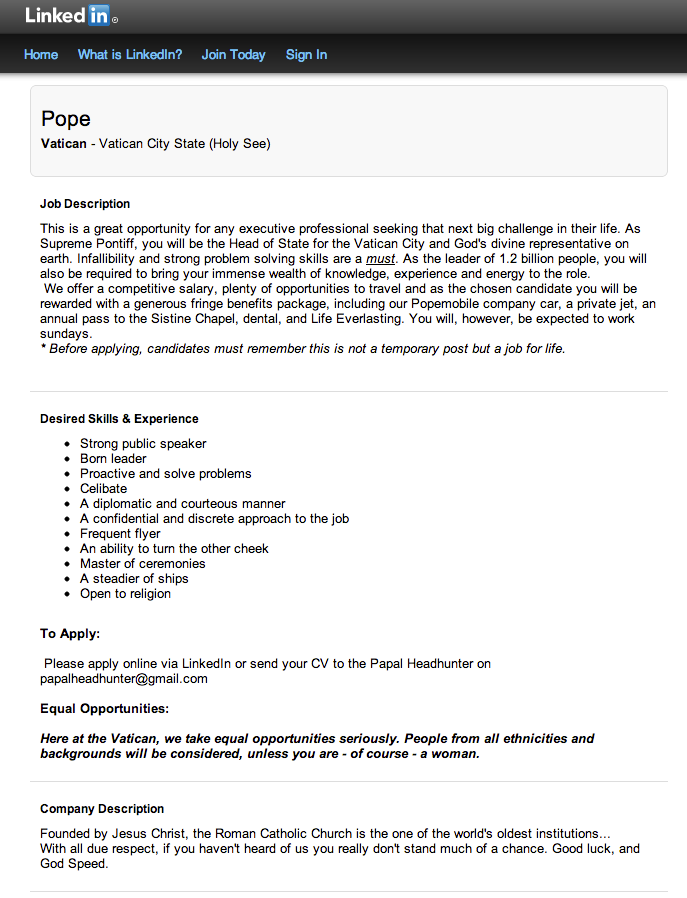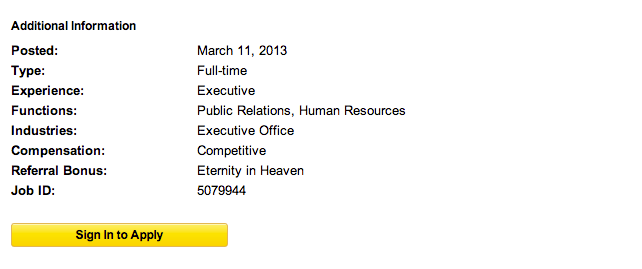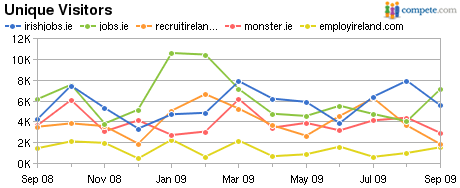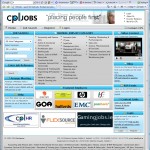An interesting job post I Stumbled Upon,… (not really, I saw it on Mashable). It is for a Pope. Is it a good job spec? I’ll let you be the judge of it yourself:


Tag: Jobs
JobBridge could only work if…
With JobBridge in the news again I couldn’t resist to clearly put myself in the ranks of those who are against it. Not like the Socialist Pary members like Paul Murphy MEP who writes JobBridge to nowhere! (I like the article!), but quite close to it. The internship scheme is a good idea and could work quite well if done right. The one we have today is very, very far from it. It is no surprise it is causing such all these troubles for the government, with the majority of people expressing themselves unusually vocally about it. And the majority of the votes are the NO votes for the national internship programme.
The internship programme could actually work well. If… If the rules are set right. Imagine that a company can ONLY get an intern if the intern will be doing exactly what the company specialises in, and if the intern will learn skills during the internship that will make him the very attractive hire for the same company he got an internship from? To put this in real life example the rules should look somewhat like this:
1. No internships for the jobs that are paid minimum wage (by that same company). Why? The government has a chance to get unemployed placed in the job and it should aim highest possible paid ones.
2. Internship can be offered where the work performed is one of the core skills of the company. A marketing company can have a marketing intern, not a web designer. A web design company can have a web designer as an intern, not a marketing person. Why? Simply because the internship is there for the intern to learn.
3. Strictly no receptionist, admin, PA, and similar internships.
4. A company must provide a Mentor for the intern. Such a mentor should prove he/she will dedicate 10% of the working time to the Intern for the training. A mentor must be a senior staff member (in years of experience) and have the skills relevant to the internship.
The internship should be exactly the same as the initial training a new hire gets in the first few months on the job. It would give the company an extended period to test and try the intern before they make a hire. A trained intern after 6 months of the internship should be a far more interesting hire than a new candidate since the company has already invested in the intern who is ready to start the work immediately (or has been doing it for the months already).
Wouldn’t this make far more sense than the Internship programme we have today?
It is funny to watch the traffic on a job site – when you remove the jobs from it!
This is a short history of the Jobs Site for Dublin Airports new Terminal 2. The site goes live with the Boom announcement on TV (11,461 visitors immediately). The next day all the national media covers the story (12,288 people on the site). Weekend – the site ‘quiets down’ with about 2,500 people a day. Next week, about 5,000 every day steadily. That all went well. Actually too well – the recruiters are simply overwhelmed by the volume of CVs (here is a Irish Jobs Site PR). So what to do next?
Remove the jobs from the Jobs site! :)
But the traditional media and by then the social media as well has done its duty. The Site is still hot! There are still a few thousand people on the site every day, so watch the change in their behaviour now – when the site has no jobs any more:
Web Site Pageviews
![]()
Drastic drop since there are no jobs to apply on a jobs site!
Pages per Visit
![]()
With no job on, there isn’t much to see on a jobs site, isn’t it?
And now my two personal gems….
Bounce Rate
BTW that figure shows the percentage of the people who come to your site, and click on no link on your site but just leave.

Well jobs site with no jobs,… ehm,… Highest bounce rate possible?
Average time spent on the site

I mean really guys? No jobs? On a jobs site?
So the job hunters answer to the Jobs Site with no jobs is: We will leave, and we will leave immediately!
I want a new job!
Be careful what you wish for!
I want a new job web site (iwantanewjob.ie) is still in Beta phase, but it does look like a job site already. The prominent placement of the job search facility on the home page is good.
Job advertising is free until the end of January 2010. The pricing is low, and the site is already hosting numerous banners trying to monetize the traffic. With the Alexa traffic ranking of 6,590,136 (This site JobsBlog.ie is on 718,509 today), meaning there is 6.5 million web sites with more traffic; it will be hard to monetize the traffic.
With the December coming, and we all know what December online job search figures are (although this recession might turn things up side down!) Iwantanewjob.ie is not likely to attract any significant traffic this year. But that was probably the plan anyway, to take some time to get the jobs up there first.
Well all the best wishes to ‘I Want a New job’ jobs site. Perhaps there should also be a site called: ‘I Want My Old Job Back’.
Jobs.ie and EmployIreland.com are the only two web sites that recorded a growth of the unique visitors numbers during September this year. According to Complete who collects the public data, as opposed to the marketing messages from the job boards, Irish Jobs, RecruitIreland and Monster both recorded a significant drop of traffic during September 2009.
September is the very important month in the online recruitment industry. In the previous ten years, almost all leading job boards would have a record numbers of visitors in September. The current recession is obviously affecting the online recruitment industry.
Are the social recruitment sites like LinkedIN and even twitter, or Irish start-ups like Jobs Market stealing the traffic from the job boards? It certainly seems the case, since the traditional job boards are obviously getting less traffic.
So what have Jobs.ie and EmplyIreland.com done to keep the traffic rising during September? A bit of SEO perhaps? What do you think?
… when all the personal branding channels are combined.
In no particular order:
1. Social networks presence – descriptive public profile combined with the active participation in discussions.
2. Personal Blog
3. Presence on the Corporate Blog
4. Any online publication (indexed by Google)
The real power of all your online presence is in the ability to connect all those channels together. Ad your friends and co workers in social networks, drive them to your blog for more status updates, get them subscribed to your RSS feeds and twitter. From your RSS and tweets send them back to your questions and discussion on your blog and social networks, and increase the readership in every jump from one media to another.
Personal branding practice as above replaces the necessity to look for a job on jobs sites. The recruiters will ‘know about you’ already anyway. Just blog daily, and publish one article or a question in the social network of your choice (relevance to your target industry).
![]() Resumark brought in a nice new business model in the online recruitment industry. The concept is essentially borrowed from the Google AdWords – Google AdSense model. While Google pays the web site owners to show the Google AdSense on their sites and charges the Google AdWords clients to pay per click for those same adverts Resumark does the same with the CVs. Job hunters upload their CVs and get paid each time someone downloads the CV. Anyone can search the CV database for free, and gets a preview of the CV for free only. If you decide you would like the contact details as well – you pay to Resumark. Resumark in return pays the cut to the owner of the CV.
Resumark brought in a nice new business model in the online recruitment industry. The concept is essentially borrowed from the Google AdWords – Google AdSense model. While Google pays the web site owners to show the Google AdSense on their sites and charges the Google AdWords clients to pay per click for those same adverts Resumark does the same with the CVs. Job hunters upload their CVs and get paid each time someone downloads the CV. Anyone can search the CV database for free, and gets a preview of the CV for free only. If you decide you would like the contact details as well – you pay to Resumark. Resumark in return pays the cut to the owner of the CV.
Just in case you did not get it, here is how Resumark explains their online recruitment and CV database business model:
Get Paid to Post Your Resume!
Post Resume or create it online using our free Resume Assistant. Make $1 every time an employer downloads your resume!
Search Jobs that match your profile and join the fastest growing Job 2.0 Network!
In today’s economy even job search monsters are not enough. Invite friends and earn money together when their resumes are downloaded.
And for the recruiters and employers:
Free Resume Search & Job Postings
Search Resumes for Free using Google™ search technology. We give you full access to the entire resume database.
Pay only for the resumes that you choose to download. Compare to other services.
Post Jobs for Free and have them automatically distributed to major jobs sites and networks reaching millions of job seekers
Regardless if the business will work or not, Resumark is a step from the usual recruitment jobs sites. Time will tell if it was a step in the right direction. But what needs to be applauded here is the courage and the innovation in the online recruitment industry.
Monster is interested in what job seekers think of their jobs web site. Here is the mail sent to job hunters today:
SATISFIED?
LET US KNOW WHAT YOU THINKDear Job Seeker,
At Monster, we are committed to creating an online experience that advances your life and your career. To help us achieve this, we would like to invite you to provide some feedback on your experience using Monster.
Our Satisfaction Survey should only take around 12 -18 minutes to complete and all responses are confidential. Start the survey by clicking the link below. Your honest thoughts and opinions are greatly appreciated.
Thank you for your participation.
Click here for the satisfaction survey »
Best wishes,
Jesse Harriot
Vice President of Research2009 Monster – All Rights Reserved
Hillview House, 15D Gilford Road, Sandymount, Dublin 4, Ireland
How about a iPhone raffle or something similar to get people to participate? Or is Monster not really interested in what people really think. Or not that much to give them the incentive to fill up the questionnaire?
Or Monster Marketing just didn’t think of it at all? :)
While many jobs can still be applied for in the traditional way, by sending a printed CV and covering letter by post to the organisation that is offering the position, an increasing number of employers now accept and even encourage the practice of sending of CVs via e-mail. There are a number of advantages to this approach – it’s almost instantaneous, it works out a lot cheaper, especially if you are applying for jobs abroad, and it reduces paper waste. In addition, some websites offer you the chance to post your CV online where it can be seen by thousands of potential employers without you having to lift a finger. An electronic CV is generally similar to a printed CV, however there are several key differences between the two forms that are important to bear in mind when producing the document.
Perhaps most importantly, you have to ensure that your CV can be easily read on any computer, regardless of software and hardware differences. For this reason it is best to save your CV in ASCII or plain text format, as the recipient may not have the same word-processing software, or even the same version of a particular program, as you have typed the CV into. Keep the formatting as simple as possible, as indents, columns, page breaks and bullet points can all be interpreted differently by different computers and leave your CV looking like a mess on arrival.
Although most paper CVs are lucky to receive anything other than a quick perusal, if anything an electronic CV will receive even less detailed attention. Therefore, it is of paramount importance that you keep it short and crisp. Summarise what you feel to be your strong points and avoid unnecessary detail. The primary function of an electronic CV is to grab the attention of the employer. If what they see intrigues them, then they will get in touch with you for more details.
For the same reason it is important to make appropriate use of keywords to draw attention to the important things in your CV, especially if it’s posted on a jobs site. Given that the great majority of internet searches are keyword-based, it is important to use words and phrases that are likely to be searched for by potential employers. Use keywords that are specifically related to the industry and the type of job you wish to work in. Try to incorporate positive, descriptive terms into descriptions of your skills and experiences that you feel employers will be likely to search for. For example, an employer looking for clerical staff might search for terms such as ‘fast and accurate typist’ or ‘strong IT skills’.
Finally, be sure to include your name, contact details and website, if you have one that you feel is worth showing to employers, along with a short profile of your career and achievements to date in reverse chronological order. If an employer is interested in your CV but finds it anything other than easy to find your contact details, chances are they won’t contact you at all.
For jobs and career advice, visit employireland.ie.
Good presentation is key to producing a successful CV. In today’s crowded jobs market, making the right impression with your CV can make all the difference between getting an interview and being completely ignored. Given that your potential future employer may well have read through a pretty big pile of applications before even casting an eye over your application, a CV that can be quickly and easily read and summarised will stand at a great advantage over those that can’t. Also, a neat, concise CV and covering letter is bound to create a far more positive impression than a tatty, poorly presented document. While there are no specific rules regarding the presentation of a CV, you can’t go too far wrong if you stick to these guidelines:
• Type up your CV on a computer using a word processing package or on a dedicated word processor. If you don’t have access to a computer at home, many public libraries offer computer use free of charge to their members and printing for a small fee.
• Use good-quality paper that looks nice, feels fairly substantial and doesn’t get tatty easily.
• Don’t go crazy with the formatting unless you’re applying for jobs where creative or artistic skills are required. In many lines of work, eccentricity is not regarded as a desirable asset. Stick with A4 paper in portrait mode, and use mainstream fonts such as Times New Roman, Arial, or Helvetica at size 11 or 12.
• Cut out unnecessary information, such as the dates of short courses or qualifications that have been superseded, to keep your CV concise and easy to read.
• Full pages look good. Don’t have a full page followed by a quarter page – if necessary cut out less important information to bring it down to size, or put in extra information or spacing to bring a nearly full page up to size.
• Use bullet points rather than paragraphs for the majority of your CV. Your personal statement or profile, however, may well benefit from the more conversational tone that paragraphs help to create.
• Summarise the experiences and qualifications that you think are the most relevant to the job in question at the beginning of your CV. Use bold type to draw the eye of the reader towards them, and try to avoid repeating them later in the CV.
For jobs and career advice, visit employireland.ie.
When it comes to applying for jobs, first impressions can count for a great deal. Very often, the very first thing a potential employer will know about you will be written on the CV that you included with your job application. Having a great CV can make all the difference between being asked for an interview and being rejected out of hand.
When writing a CV, it is helpful to consider things from the employer’s point of view. They will be looking for those people who would seem, at least on paper, ideally suited to the position being offered. They may well have to read through a great number of CVs before they decide which candidates they wish to interview, so they will, naturally, be looking for the ones that really stand out from the crowd.
While using the same CV for a variety of job applications, and changing only the covering letter, might seem a time-efficient way of applying for jobs, this approach has several drawbacks. Chiefly, it will decrease the chances that your CV is truly marketing you as a person well suited to the demands of the job in question. In addition, sending in a generic CV unmodified to the demands of a particular job, especially now in this digital age, smacks of laziness, incompetence, and a lack of desire for the job – hardly an image that you would want to project to a potential employer!
By tailoring your CV to the job you are applying for, you can significantly increase your chances of being asked to come in for an interview. In order to do this successfully, you will need to do some research into the background of the organisation in question as well as judging the personal characteristics and qualifications that they would seem to be looking for in an applicant.
Not only should your CV be tailor-made for each and every one of the jobs that you apply for, it should also be updated regularly to take account of any advances you have made in your education and career. It would probably be a good idea to keep a constantly updated ‘master’ CV file on your home computer, which can then be quickly customized to highlight the qualifications and personal attributes required by the jobs that you are applying for.
For jobs and career advice, visit employireland.ie.
![]() Twitter is surprisingly good tool for the recruitment. You can track the conversations and when used in conjunction with LinkedIN or any other tool it shows the real time live activity of the person. As does Facebook. Monster or any other CV database will never tell you that. An application from a job site or your web site will never tell you what a person is really about. Twitter does. It also tells you what other people think the person is about. And that is unique in the recruitment industry.
Twitter is surprisingly good tool for the recruitment. You can track the conversations and when used in conjunction with LinkedIN or any other tool it shows the real time live activity of the person. As does Facebook. Monster or any other CV database will never tell you that. An application from a job site or your web site will never tell you what a person is really about. Twitter does. It also tells you what other people think the person is about. And that is unique in the recruitment industry.
Do not try to recruit by using Twitter alone. But you can use Twitter to find the conversation about topics. You can use the job skill as the topic, or even better a conference or something that has a time factor. You can find people that are talking about the certain themes – related to the job or a position you are trying to fill. Find who is talking about it, what do they talk about it and who do they talk about it to. There is your talent pool, with reference check, and a real time data about their recent activity.
Or you can put it all upside down. You talk about what you do. People who use Twitter well will know how to find you. Actually they will find what you have to offer, and that is your jobs. Talk, tweet, comment others, follow, you will get the lingo quickly. Find people that you know and respect, follow, monitor their followers. Just be active, as you would be on any networking event. Twitter is actually just one constant networking event. It is happening with or without you. It will not wait for you. You need to be in to meet the people you want to meet.
 American marketing was always a bit specific. In some cases it just does not ‘cross the water’ well, and sounds a bit off on our shores here. In recruitment the example is the job site Hound.com. It is a Employers Only model job site, like Ireland has its own RealJobs.ie. It’s marketing is very original and different from the usual jobs sites. On Hound everything is about the hounds and the front page is full of dogs images. 13 dogs will welcome you on the Hound home page. Quite impressive for the jobs site, isn’t it?
American marketing was always a bit specific. In some cases it just does not ‘cross the water’ well, and sounds a bit off on our shores here. In recruitment the example is the job site Hound.com. It is a Employers Only model job site, like Ireland has its own RealJobs.ie. It’s marketing is very original and different from the usual jobs sites. On Hound everything is about the hounds and the front page is full of dogs images. 13 dogs will welcome you on the Hound home page. Quite impressive for the jobs site, isn’t it?
This is Hound they think you should use them:
Hound shows its members jobs from every employer website it can find in the United States and throughout the world. It is the most powerful job-search engine in existence and powers several job boards. Recruiters use Hound to track down potential jobs for their clients.
Meaning: If there is a job, Hound will sniff it!
 Photo credit: Myung Jung Kim/PA Wire
Photo credit: Myung Jung Kim/PA Wire
Evening Echo:
Jobs in a new McDonald’s branch in Ennis have attracted applications from unemployed bankers, architects and accountants.
There were 500 applications for jobs in the new branch in 10 days. The jobs were advertised solely on a banner at the site which was taken down after 10 days because franchisee Kieran McDermott had received so many CVs.
He said the situation was the direct opposite in 2002, when he opened a branch in Shannon.
Employees were difficult to find then, as Ireland was at the height of the boom with very low levels of unemployment.
Career Builder is comming to Ireland!
Something strange happened today. First a well known Irish Recruitment agency called on the phone this morning and asks if we can post their jobs via our Multiple Jobs Posting service to the CareerBuilder job site. I found it strange because CareerBuilder is an old site and it used to be US oriented so far. So I checked and guess what? There is a CareerBuilder.ie Irish site.
I looked around and it has about 15 clients advertising jobs. Not overtly impressive, but hey!? It’s a start. CareerBuilder is in Ireland!
As the day goes by, I was checking some recruitment sites of the Irish recruitment agencies to get some inspiration, and guess what? Cpl has a new web site. I actually liked the old one better. But this one has all the right things that a recruitment site should have today: Video, blogs, and this giant footer made of gazillion links. I watched the video. And noticed that the vide on the CPL web site is an advertisement for the CareerBuilder! I still do not get what is he jobs site advertisement actually doing on a recruitment agency web site. Beats me!

